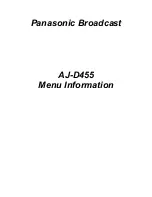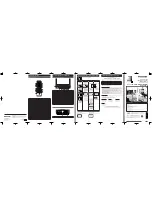
GRUNDIG Servicetechnik
2 - 15
GV470S…
Beschreibungen / Descriptions
Endstufe "VHS / S-VHS" (T7675 / T7627). An dieser wird das 627kHz-
Chromasignal über R3678 und C2678 zum FM-Signal addiert. An-
schließend leitet man es über den Steckerkontakt 1530-(3), dem
Einsteller R3684 (YWV) für die Aufsprechspannung auf der Chassis-
platte und von dort dem Kopfverstärker zu.
Wiedergabe
Bei Wiedergabe gelangt das geregelte FM-Signal vom Band über den
Kopfverstärker, die Chassisplatte und Steckerkontakt 1530-(4) zum
Emitterfolger T7545. Anschließend teilt sich der Signalverlauf für
S-VHS- und VHS-Wiedergabe.
– VHS-Wiedergabe
Das FM-Signal leitet man nach dem Emitterfolger T7545 über einen
"FM-Peaking"-Kreis für VHS (C2555 / F1055) zu einem Verstärker
(T7565), an dessen Emitter ein 9MHz-Sperrkreis (L5565 / C2565) ist.
Nach der Laufzeitkorrektur - Allpaß (F1060 / C2575 / C2577 / L5577)
- und dem Transistor T7585, der über die Schaltspannung
U VHS
freigegeben wird, durchläuft es einen 627kHz-Sperrkreis (C2587 /
L5587). Anschließend gelangt es über den Emitterfolger T7588 zum
Pin 30 des IC7840. In diesem führt man das FM-Signal einerseits über
einen Tiefpaß und andererseits über einen Hochpaß sowie die folgen-
de Begrenzerstufe zur Mixstufe. Nach einer weiteren Begrenzerstufe
wandelt man es im FM-Demodulator in ein BAS-Signal um. Das
Deemphasisglied (R3705 / C2705 / R3703) ist über Pin 36 wirksam.
Im IC7840 durchläuft es noch einen 2,5dB-Verstärker und gelangt
über Pin 4 sowie ein Tiefpaßfilter F1080 zum IC7840-(14). In diesem
führt man das BAS-Signal über einen Wahlschalter (S-VHS/VHS), den
5,3dB-Verstärker und die NLDE-Stufe zum IC7840-(6). Nach dem
Kondensator C2901 wird es wieder am Pin 8 in den IC7840 einge-
speist. Zwischen den Pins 8 und 43 des IC7840 durchläuft das BAS-
Signal im wesentlichen Stufen für Dropout-Kompensation, Rausch-
unterdrückung, Höhenanhebung "Picture Control" (APT CONT),
V-Impulseintastung (A.L V/H) und zur Pegelanpassung. Die Einstel-
lung der Höhenanhebung erfolgt über das Schieberegister 6,
IC7590-(11)…-(13), dem folgenden D/A-Wandler (R3820…R3827)
und Pin 40 des IC7840. Anschließend leitet man das BAS-Signal vom
IC7840-(43) über den Steckerkontakt 1530-(27) zum IN/OUT-
Schaltungsteil. Von dort gelangt es zum Modulator, zur S-VHS-
Buchse und zu den EURO-AV-Buchsen.
– S-VHS-Wiedergabe
Das FM-Signal leitet man nach dem Emitterfolger T7545 über einen
"FM-Peaking"-Kreis für S-VHS (C2518 / F1050) zu einem Verstärker
(T7520), an dessen Emitter ein 12,5MHz-Sperrkreis (L5520 / C2520)
ist. Nach der Laufzeitkorrektur - Allpaß (F1052…C2540) - und dem
Transistor T7542, der über die Schaltspannung
U S-VHS
freigege-
ben wird, durchläuft es einen 627kHz-Sperrkreis (C2587 / L5587) und
den Emitterfolger T7588. Anschließend gelangt es über einen Hoch-
paß (C2743 / R3745) zum IC7840-(26) sowie über einen Tiefpaß
(R3730 / C2732) zum IC7840-(29). In diesem führt man das FM-Signal
von Pin 29 direkt zur MIX-Stufe und das von Pin 26 über die Begrenzer-
stufe. Nach einer weiteren Begrenzerstufe wandelt man es im FM-
Demodulator in ein BAS-Signal um. Das Deemphasisglied (R3705 /
C2705 / R3703) ist über Pin 36 wirksam. Im IC7840 durchläuft es noch
einen 2,5dB-Verstärker und gelangt über Pin 4 sowie je ein Tiefpaß-
filter für 3MHz (F1080) und für 5MHz (F1090) zum IC7930-(8), -(10).
Entsprechend der Bildauflösung (3MHz / 5MHz) wird eines der BAS-
Signale zum Pin 6 durchgeschaltet und an IC7840-(16) weitergeleitet.
Die Steuerung des IC7930 erfolgt über die Steuerspannung
U COMP
vom Schieberegister 5, IC7610-(13). Im IC7840 führt man das BAS-
Signal über einen Wahlschalter (S-VHS/VHS), den 5,3dB-Verstärker
und die NLDE-Stufe zum IC7840-(6). Nach der S-VHS-Sub-Emphasis
(IC7898, Pins 14 / 7) wird es wieder am Pin 7 in den IC7840 einge-
speist. Zwischen den Pins 8 und 43 des IC7840 durchläuft das BAS-
Signal im wesentlichen Stufen für Dropout-Kompensation, Rausch-
unterdrückung, Höhenanhebung "Picture Control" (APT CONT),
V-Impulseintastung (A.L V/H) und zur Pegelanpassung. Die Einstel-
lung der Höhenanhebung erfolgt über das Schieberegister 6,
IC7590-(11)…-(13), dem folgenden D/A-Wandler (R3820…R3827)
und Pin 40 des IC7840. Anschließend leitet man das BAS-Signal vom
IC7840-(43) über den Steckerkontakt 1530-(27) zum IN/OUT-
Schaltungsteil. Von dort gelangt es zum Modulator, zur S-VHS-
Buchse und zu den EURO-AV-Buchsen.
chroma signal is added with the FM signal via R3678 and C2678.
Subsequently, it is routed via the plug contact 1530-(3), the adjustment
control R3684 (YWV) for the recording voltage on the Family Board
and arrives at the head amplifier.
Playback
On playback, the controlled FM signal from the tape is passed through
the head amplifier, the Family Board and plug contact 1530-(4) to the
emitter follower T7545. Subsequently, the signal path divides for
S-VHS and VHS playback.
– VHS Playback
After the emitter follower T7545, the FM signal is routed via a "FM-
Peaking" circuit for VHS (C2555 / F1055) to an amplifier (T7565), at the
emitter of which a 9MHz trap (L5565 / C2565) is located. After delay
time correction - all-pass (F1060 / C2575 / C2577 / L5577) - and the
transistor T7585 which is turned on by the switching voltage
U VHS
the signal is subjected to a 627kHz trap (C2587 / L5587). Subse-
quently, it is supplied via the emitter follower T7588 to Pin 30 of IC7840.
In This IC, the FM signal is taken on one path via a lowpass and on
another path via a highpass and the limiting stage which follows to the
MIX circuit. Having passed through another limiting stage, the signal
is converted by the FM demodulator to a CVS signal. The de-emphasis
circuit (R3705 / C2705 / R3703) is operated via Pin 36. In IC7840, the
signal is also fed through a 2.5dB amplifier and arrives via Pin 4 and
a lowpass filter F1080 at IC7840-(14). In this IC, the CVS signal is taken
via a selection switch (S-VHS/VHS), the 5.3dB amplifier and the NLDE
stage to IC7840-(6). After the capacitor C2901, the signal is fed back
to Pin 8 of IC7840. Between the Pins 8 and 43 of IC7840, the essential
circuits the CVS signal has to pass through are stages for drop-out
compensation, noise reduction, frequency lifting "Picture Control"
(APT CONT), V-pulse insertion (A.L V/H) and for level control. Control
of high frequency lift is effected via the shift register 6,
IC7590-(11)…-(13), the D/A-converter (R3820…R3827) which fol-
lows and Pin 40 of IC7840. Subsequently, the CVS signal is passed
from IC7840-(43) through plug contact 1530-(27) to the IN/OUT circuit
stage. Form this stage, it is supplied to the S-VHS socket and to the
EURO-AV sockets.
– S-VHS Playback
After the emitter follower T7545, the FM signal is routed via a "FM-
Peaking" circuit for S-VHS (C2518 / F1050) to an amplifier (T7520) at
the emitter of which a 12.5MHz trap (L5520 / C2520) is located. After
delay time correction - allpass (F1052…C2540) - and the transistor
T7542 which is turned on by the switching voltage
U S-VHS
the signal
is subjected to a 627kHz trap (C2587 / L5587) and the emitter follower
T7588. Subsequently, it is supplied via a highpass filter (C2743 /
R3745) to IC7840-(26) and via a lowpass filter (R3730 / C2732) to
IC7840-(29). In this IC, the FM signal from Pin 29 is directly applied to
the MIX stage, the signal from Pin 26 arrives there via the limiting stage.
Having passed through another limiting stage, the signal is converted
by the FM demodulator to a CVS signal. The de-emphasis circuit
(R3705 / C2705 / R3703) is operated via Pin 36. Moreover, in IC7840
the signal is fed through a 2.5dB amplifier and arrives via Pin 4 and one
3MHz lowpass filter (F1080) and one 5MHz lowpass filter (F1090)
each at IC7930-(8), -(10). Dependent on the picture resolution (3MHz /
5MHz) one of the CVS signals is switched to Pin 6 and passed on to
IC7840-(16). Control of IC7930 is effected by the switching voltage
U COMP
from shift register 5, IC7610-(13). In IC7840, the CVS signal
is taken via a selection switch (S-VHS/VHS), the 5.3dB amplifier and
the NLDE stage to IC7840-(6). After the S-VHS sub-emphasis (IC7898,
Pins 14 / 7) the signal is fed back into IC7840 at Pin 7. Between the
Pins 8 and 43 of IC7840, the essential circuits the CVS signal has to
pass through are stages for drop-out compensation, noise reduction,
high frequency lifting "Picture Control" (APT CONT), V-pulse insertion
(A.L V/H) and for level control. Control of high frequency lift is effected
via the shift register 6, IC7590-(11)…-(13), the D/A-converter
(R3820…R3827) which follows and Pin 40 of IC7840. Subsequently,
the CVS signal is passed from IC7840-(43) through plug contact
1530-(27) to the IN/OUT circuit stage. From this stage, it is supplied to
the modulator, the S-VHS socket and to the EURO-AV sockets.
















































